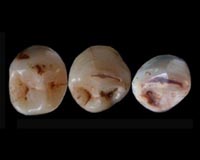| . |  |
. |
Tempe AZ (SPX) Feb 16, 2011 A fossilized foot bone recovered from Hadar, Ethiopia, shows that by 3.2 million years ago human ancestors walked bipedally with a modern human-like foot, a report that appears Feb. 11 in the journal Science, concludes. The fossil, a fourth metatarsal, or midfoot bone, indicates that a permanently arched foot was present in the species Australopithecus afarensis, according to the report authors, Carol Ward of the University of Missouri, together with William Kimbel and Donald Johanson, of Arizona State University's Institute of Human Origins. The research helps resolve a long-standing debate between paleoanthropologists who think A. afarensis walked essentially as modern humans do and those who think this species practiced a form of locomotion intermediate between the quadrupedal tree-climbing of chimpanzees and human terrestrial bipedalism. The question of whether A. afarensis had fully developed pedal, or foot, arches has been part of this debate. The fourth metatarsal described in the Science report provides strong evidence for the arches and, the authors argue, support a modern-human style of locomotion for this species. The specimen was recovered from the Hadar locality 333, popularly known as the "First Family Site," the richest source of A. afarensis fossils in eastern Africa, with more than 250 specimens, representing at least 17 individuals, so far known. "This fourth metatarsal is the only one known of A. afarensis and is a key piece of evidence for the early evolution of the uniquely human way of walking," says Kimbel. "The ongoing work at Hadar is producing rare parts of the skeleton that are absolutely critical for understanding how our species evolved." Humans, uniquely among primates, have two arches in their feet, longitudinal and transverse, which are composed of the midfoot bones and supported by muscles in the sole of the foot. During bipedal locomotion, these arches perform two critical functions: leverage when the foot pushes off the ground and shock absorption when the sole of the foot meets the ground at the completion of the stride. Ape feet lack permanent arches, are more flexible than human feet and have a highly mobile large toe, important attributes for climbing and grasping in the trees. None of these apelike features are present in the foot of A. afarensis. "Understanding that the foot arches appeared very early in our evolution shows that the unique structure of our feet is fundamental to human locomotion," observes Ward. "If we can understand what we were designed to do and how natural selection shaped the human skeleton, we can gain insight into how our skeletons work today. Arches in our feet were just as important for our ancestors as they are for us." This species, whose best-known specimen is "Lucy," lived in eastern Africa 3.0??.8 million years ago. Prior to A. afarensis, the species A. anamensis was present in Kenya and Ethiopia from 4.2 to 4.0 million years ago, but its skeleton is not well known. At 4.4 million years ago, Ethiopia's Ardipithecus ramidus is the earliest human ancestor well represented by skeletal remains. Although Ardipithecus appears to have been a part-time terrestrial biped, its foot retains many features of tree-dwelling primates, including a divergent, mobile first toe. The foot of A. afarensis, as with other parts of its skeleton, is much more like that of living humans, implying that by the time of Lucy, our ancestors no longer depended on the trees for refuge or resources. The Hadar project is the longest running paleoanthropology field program in the Ethiopian rift valley, now spanning more than 38 years. Since 1973, the fieldwork at Hadar has produced more than 370 fossil specimens of Australopithecus afarensis between 3.4 and 3.0 million years ago - one of the largest collections of a single fossil hominin species in Africa - as well as one of the earliest known fossils of Homo and abundant Oldowan stone tools (ca. 2.3 million). Through ASU's Institute of Human Origins, the Hadar project plays an important role in training Ethiopian scholars by offering graduate degree and postdoctoral opportunities in the U.S. Promotion of local awareness of the global scientific importance and Ethiopian cultural heritage value of the Hadar site is also a project priority. Additionally, the fundraising phase of a planned "Hadar Interpretive Center" at Eloaha town, 30 kilometers from the site, was successfully completed in January 2011.
Share This Article With Planet Earth
Related Links Institute of Human Origins All About Human Beings and How We Got To Be Here
 Ancient Teeth Raise New Questions About The Origins Of Modern Man
Ancient Teeth Raise New Questions About The Origins Of Modern ManBinghamton, NH (SPX) Feb 16, 2011 Eight small teeth found in a cave near Rosh Haain, central Israel, are raising big questions about the earliest existence of humans and where we may have originated, says Binghamton University anthropologist Rolf Quam. Part of a team of international researchers led by Dr. Israel Hershovitz of Tel Aviv University, Qaum and his colleagues have been examining the dental discovery and recentl ... read more |
|
| The content herein, unless otherwise known to be public domain, are Copyright 1995-2010 - SpaceDaily. AFP and UPI Wire Stories are copyright Agence France-Presse and United Press International. ESA Portal Reports are copyright European Space Agency. All NASA sourced material is public domain. Additional copyrights may apply in whole or part to other bona fide parties. Advertising does not imply endorsement,agreement or approval of any opinions, statements or information provided by SpaceDaily on any Web page published or hosted by SpaceDaily. Privacy Statement |